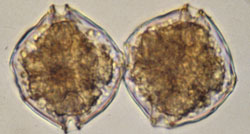Click Here for information about the West Coast HAB Summit
Why is this issue important?
A small percentage of algal species cause harm to humans and the environment through toxin production or excessive growth—these are the harmful algae and they include both microalgae (microscopic, single celled organisms) and macroalgae (seaweeds). Some harmful algae produce potent toxins which cause illness or death in humans and marine organisms—fish, seabirds, manatees, sea lions, turtles, and dolphins are some commonly affected animals. Other types of harmful algae are nontoxic to humans but cause harm to fish and invertebrates by damaging or clogging their gills or by forming such large blooms that the death and subsequent decay of the algae lead to hypoxia (oxygen depletion) in the bottom waters of marine environments. Dense blooms can also block sunlight for beneficial algae and seagrasses.
HABs can have major negative impacts on local economies, and a recent conservative assessment estimates that HABs occurring in marine waters alone have an average annual impact of $82 million dollars in the U.S.

Magnified HAB cells (Alexandrium). Photo credit: WHOI
All U.S. coastal states have experienced HABs over the last decade, and new species have emerged in some locations that were not previously known to have problems. HABs occur naturally, but human activities that disturb ecosystems in the form of increased nutrient loadings and pollution, food web alterations, introduced species, and water flow modifications have been linked to the increased occurrence of some HABs.
How are we addressing this issue?
NOAA’s goal is to provide tools to prevent, control, or mitigate the occurrence of HABs and their impacts. In the 10 years following the passage of the original Harmful Algal Bloom and Hypoxia Research and Control Act (HABHRCA), CSCOR HAB Programs have made significant advances that have improved HAB management. More accurate and efficient tools for detecting cells and toxins, early warning of toxic blooms, better predictions of when and where the blooms will move, and partnerships developed that allow for more effective response are just a few examples of how CSCOR-supported HAB research has benefited society. Because the challenges for managing HABs differ among regions of the country, CSCOR maintains a regional approach to its research that will continue to advance management capabilities in dealing with all the Nation’s major HAB threats.